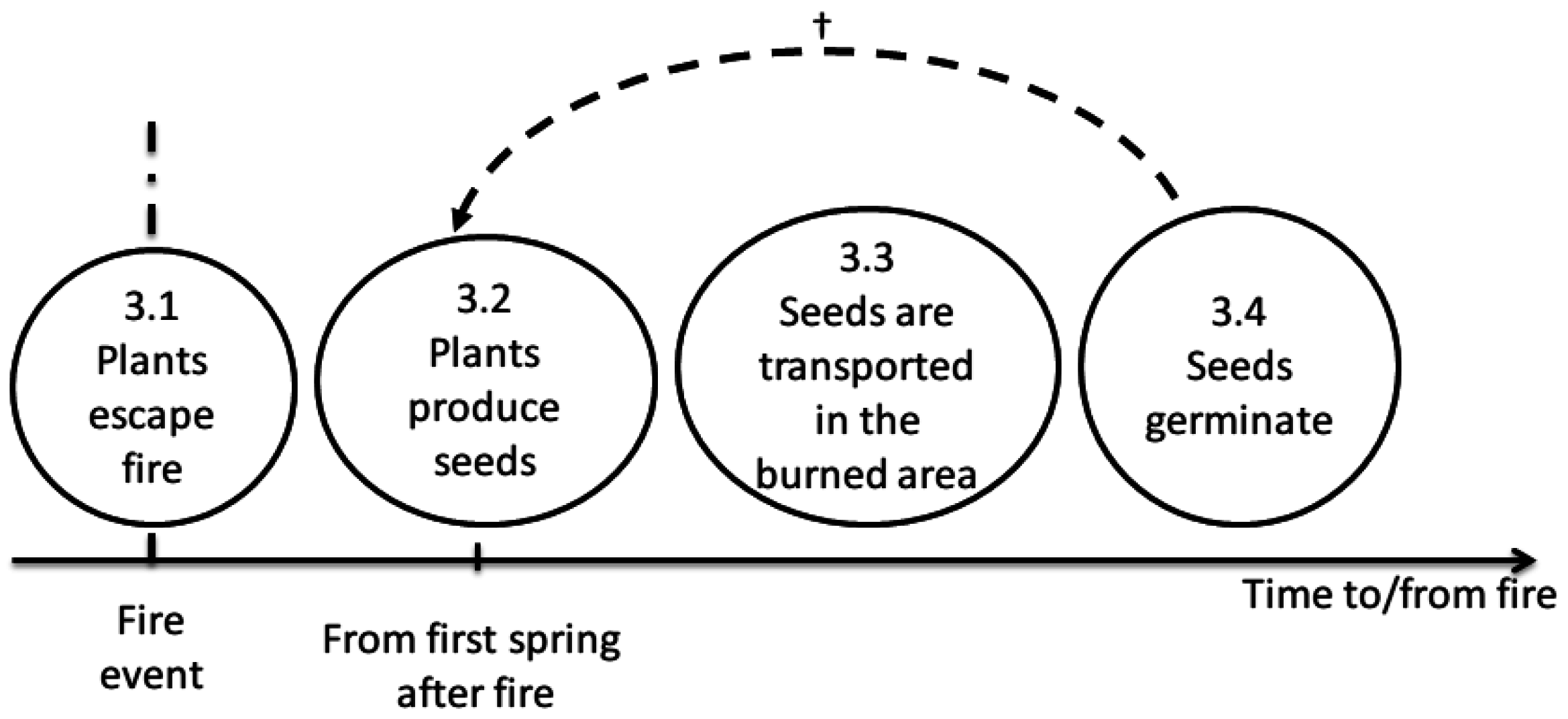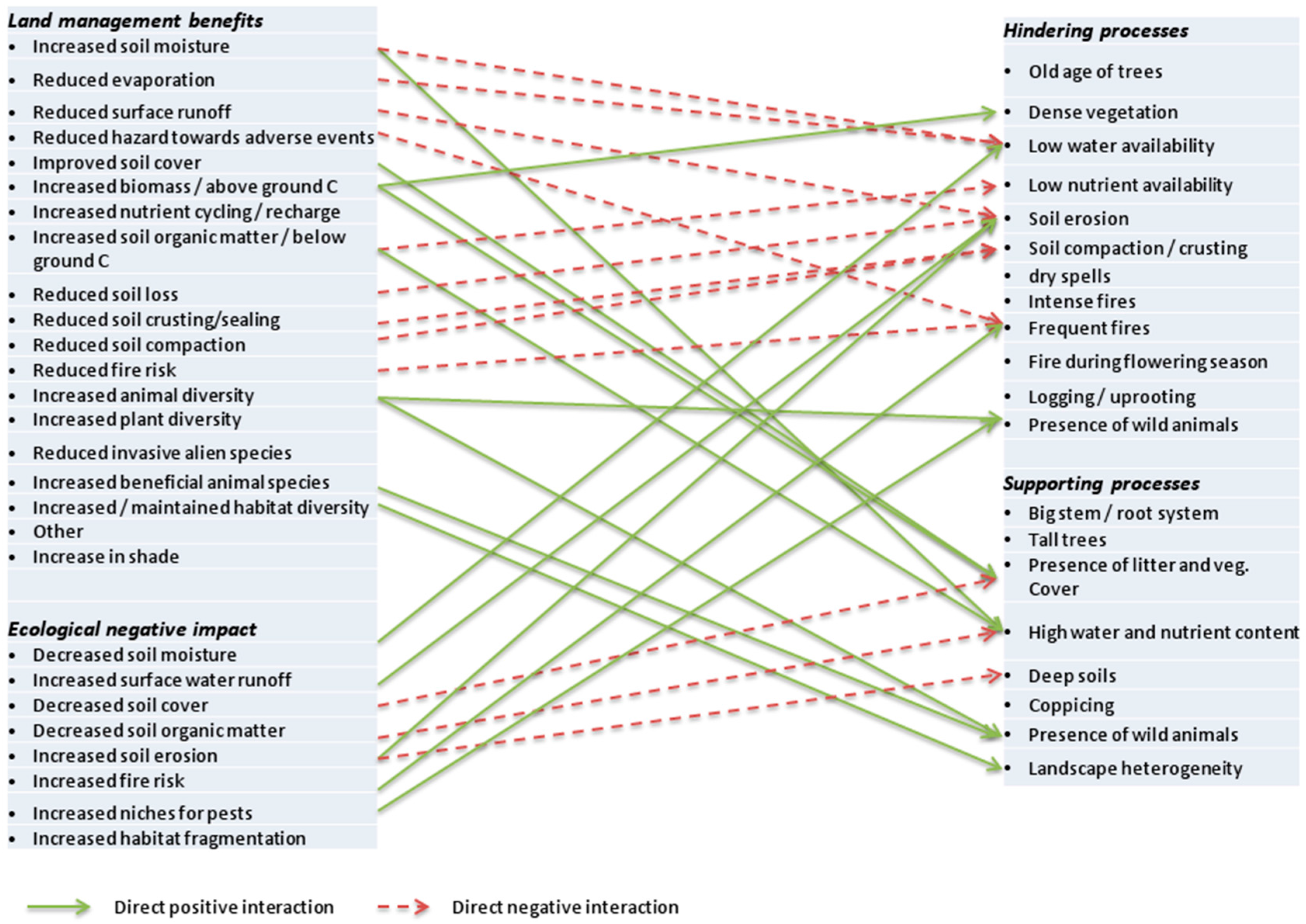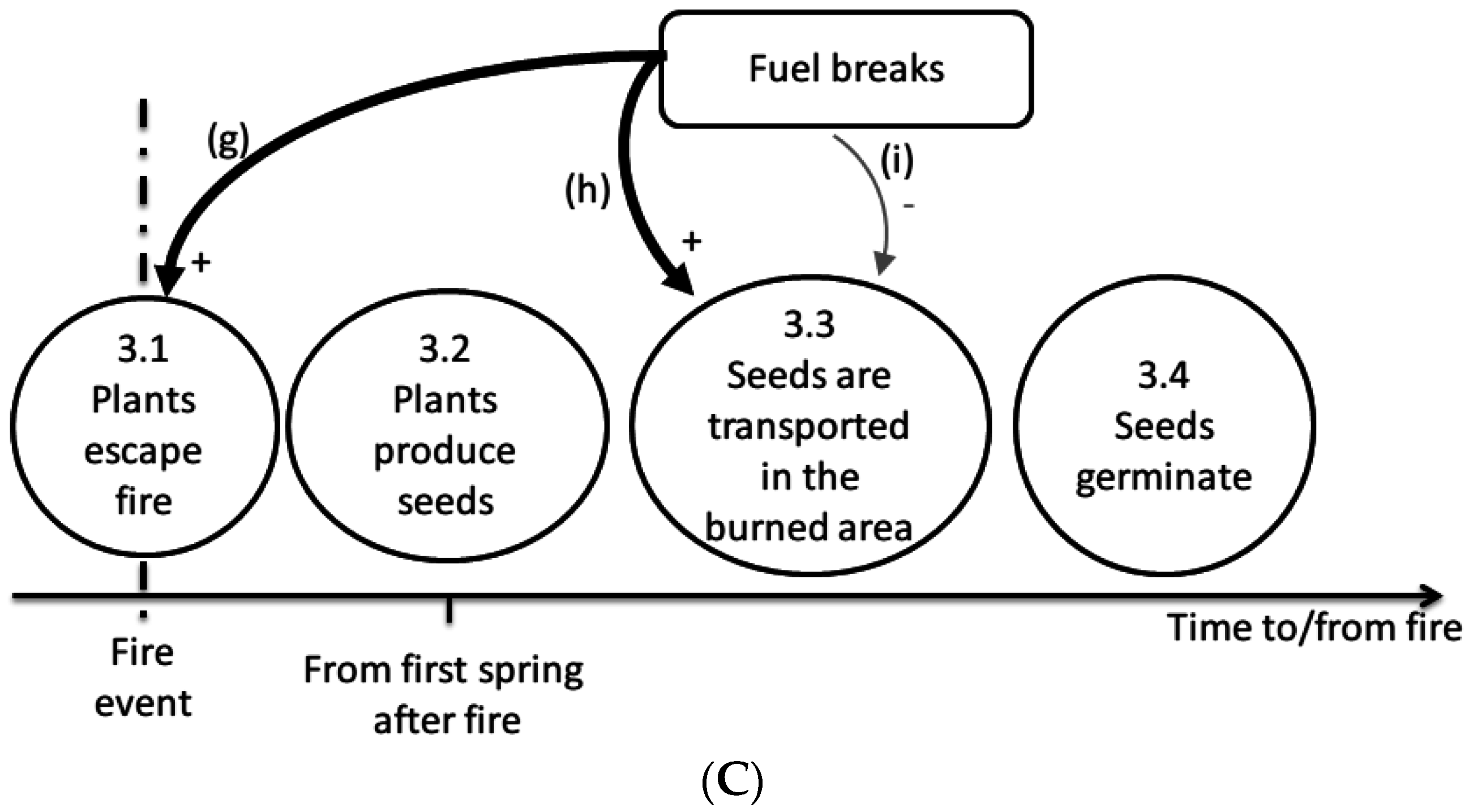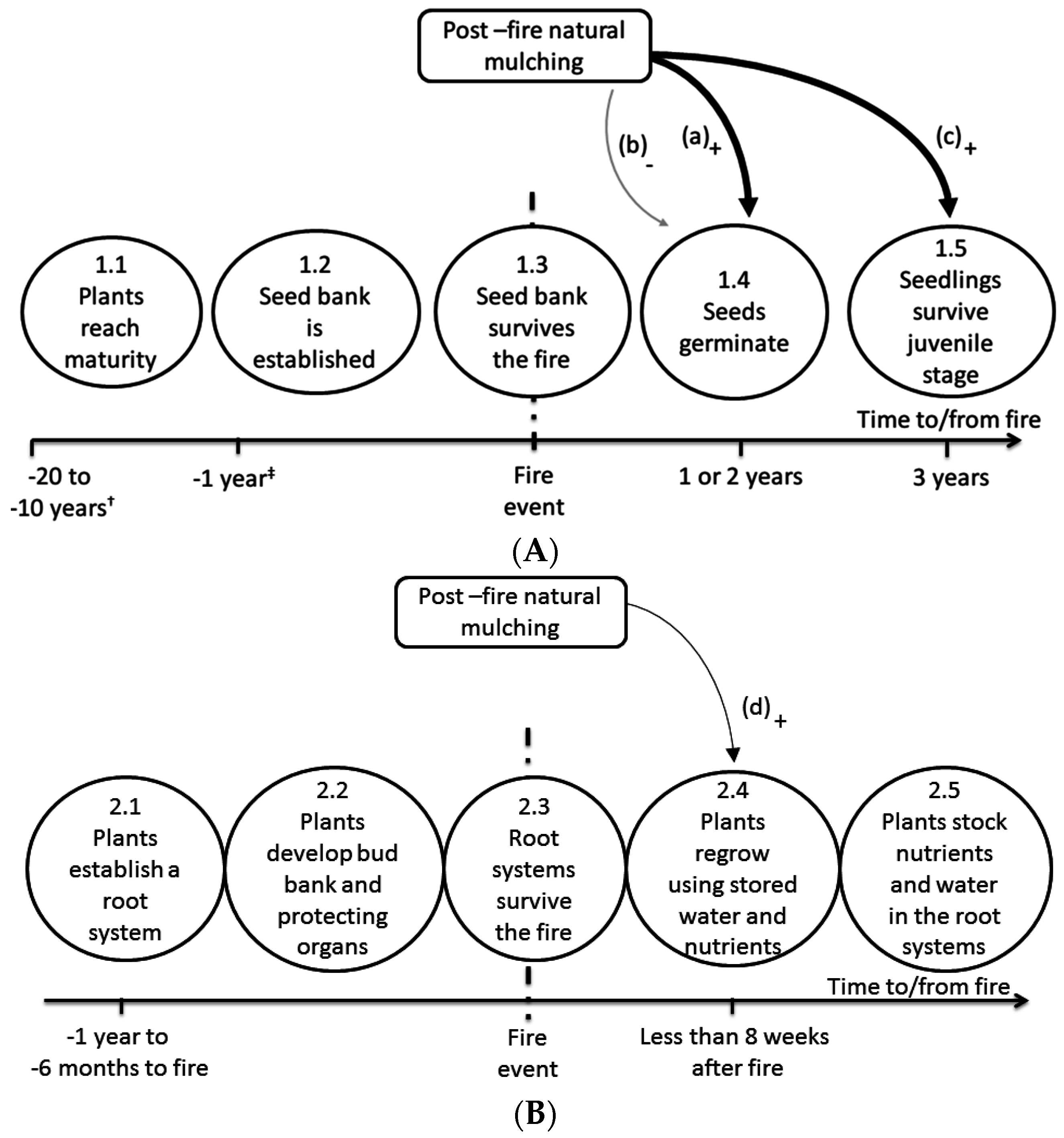3.4.1. Relationship between WOCAT Ecological Indicators and Factors Hindering and Supporting Resilience
Nine land management practices in the WOCAT database [
12] were identified as relevant for this study. They cover prevention (before the fire), fire impact mitigation, and rehabilitation (after the fire). For the purpose of the subsequent analysis we grouped them according to their objectives: (1) fuel breaks; (2) fuel management; (3) afforestation; and (4) mulching (
Table 6). Three of the management practices were documented and assessed in Spain (SPA), three in Portugal (POR), two in Italy (ITA), and one in Morocco (MOR). The summary result sheet for each management practice referenced in
Table 6 is available as
Supplementary Material.
Among other information, the WOCAT assessment method includes an evaluation of the technology based on indicators of benefits and disadvantages. Many of these can be related to the hindering and supporting factors identified for the three RMs.
Figure 4 provides an overview of these relations.
In the following subsections, we present the four groups of land management options and assess how their ecological indicators relate to the factors hindering and supporting each regeneration mechanism. In doing so, we identify hindering and supporting interactions between land management practices and resilience.
3.4.2. Fuel Breaks
Fuel breaks are linear features within the forest where the vegetation has been removed. Their placement depends on the slope, location of roads, and average wind direction. They are probably the most common management practice and are often the first staple in national programmes to reduce the risk of fire [
40]. Researchers and technical experts stress that fuel breaks not only help prevent fires from spreading, but also make it easier to access areas and conduct interventions during a fire event [
5].
Fuel breaks are implemented in networks over large areas of forest. Resulting forest structures are characterized by wide forest areas interspersed with linear discontinuities of varying width. Thus, fuel breaks have a limited effect on the forest structure as a whole [
41].
Reported aims of this land management practice are to reduce forest continuity and the area potentially affected by fire (SPA), to slow down the progress of fire (ITA), to provide access and increase safety for fire fighters during interventions (SPA, ITA, POR), and to protect roads, infrastructure, and areas of special value (POR). In the case of large fuel breaks, their central part is cleared to the mineral soil, while adjacent areas are left with an increasing density of vegetation (SPA, POR), with a selection of the biggest and most fire-resistant species (SPA).
The main benefit of fuel breaks, as assessed with the WOCAT methodology, is the reduction of fire risk (SPA, ITA, POR). Disadvantages include decreased soil cover (SPA, POR), increased surface water runoff (SPA, POR), decreased soil organic matter (SPA, POR), increased soil erosion (SPA, POR), and increased habitat fragmentation (SPA) (see
Table 7). The decrease in soil cover and soil organic matter, as well as the increase in runoff only affect the area actually occupied by the fuel break and have no relevant impact on the surrounding forested area (see
Table 7, “Average value”).
Figure 5 gives an overview of supporting and hindering interactions between fuel breaks and the three RMs. As shown in
Section 3.1.3, fire frequency is a major hindering factor for RM1. By limiting the spread of fire, fuel breaks reduce the number of fires occurring in a specific area, thus increasing the likelihood of plants reaching maturity [
40,
41]. This is shown as interactions (a) and (d) in
Figure 5. Fuel breaks might indirectly reduce the occurrence of fires in spring or autumn, thereby increasing the probability of a healthy seed bank existing at the moment of fire (b). The negative impacts of fuel breaks on soil (increased erosion, runoff, decreased cover, decreased organic matter: see
Table 7) could decrease germination rate, either on the fuel break itself or in its proximity (c).
Fuel breaks have no relevant effect on RM2, as they do not affect fire intensity, and local soil conditions have no impact on resprouting trees outside the fuel break area. If selective cutting is applied at the margins of the fuel break, this could increase the average size of plants and the presence of resprouters (e) [
42]. The only potential negative effect might occur if fire were excluded permanently from the area, as this would enable resprouter plants to reach senescence age and lose their resprouting capacity (see
Section 3.2.3) (f).
The size of the burned area and canopy continuity are major hindering factors for RM3, as they affect the number of patches that survive the fire unburned and the probability of seeds reaching the burned area. By reducing both factors, fuel breaks play an important role in ensuring the effectiveness of the RM (g, h) [
42]. However, fuel breaks of the largest category, whose total width may reach up to 90 m (SPA, POR), may act as an ecological barrier to recolonization, and increase the possibility of alien species proliferation, hindering forest resilience through RM3 [
43] (k).
3.4.3. Fuel Management
One of the ways to reduce fire risk is by removing part of the flammable material from the forest. This can be dead material, the understory, or selected individuals (e.g., fire-prone species and senescent or ill plants). It may even involve temporary total removal of the canopy, as in prescribed burning. This group of forest management practices, while having the same objective, is indeed very diverse in effects and measures. Selective clearing is the more labour-intensive option, which not only enables modification of the fuel load, but also modification of species composition and the structure of the forest stand. Depending on the type of forest, it can involve removal of seedlings and young trees to facilitate the development of bigger, less flammable trees; it can also include pruning the lower branches of the trees in order to reduce the possibility of fire spreading from the ground to the tree-level canopy. Prescribed burning does not allow for direct selection of material for removal, and it includes risks of losing proper control and generating a wildfire. Moreover, many researchers stress the negative impacts of prescribed burning on soils, but debate over the trade-offs of this management practice remains ongoing [
44].
Reported objectives include reducing the amount of fuel present in the area (SPA, POR, ITA), creating or increasing discontinuity in the canopy (SPA, POR), preventing the spread of alien species and pests (SPA, POR), and changing canopy composition to include more fire-resistant species or increase diversity (SPA, POR). Fuel management can be achieved through prescribed burning (POR), cutting and removal of vegetation (SPA), or cutting and chipping of wood which is then used as mulch (SPA, ITA).
Relevant benefits of these management practices are: reduced wildfire risk (ITA, SPA, POR), increased biological pest/disease control (POR), and increased habitat diversity (SPA, POR). In the case of selective cutting, benefits also include a reduction in alien/invasive species (POR). Further benefits occur if the wood is chipped and dispersed on site as mulch: among others, the proportion of soil covered by litter increases, nutrients are recharged, soil moisture increases, and soil crusting or sealing is reduced (SPA). Negative impacts of fuel management technologies include increased soil erosion, decreased soil cover and organic matter (if mulching is not applied), and increased habitat fragmentation (
Table 8).
The impacts of fuel management on the three RMs are shown in
Figure 6. Looking at RM1, a reduction in fuel decreases fire intensity, with a positive impact on seed bank survival [
42] (a). However, if fuel management is implemented through prescribed burning, it will have a negative impact on the soil [
45], resulting in a reduced germination rate (b). Positive impacts on RM1 further include reduced vegetation density, leading to reduced competition and hence increased probability of seedlings reaching maturity and producing seeds. Mulching increases soil fertility and seed sheltering, and most likely leads to an increase in the germination rate (c) [
46], if the mulch layer is not too thick.
Resprouter species, which use RM2, benefit above all from reduced competition with seeder species before the fire, increasing their chances of survival and their resprouting vigour (d); this applies to both selective clearing and prescribed burning. In the case of selective clearing, the most fire-prone species are usually cut, allowing more fire-resistant species such as
Quercus,
Juniperus, and
Fraxinus species to grow in size, increasing their chances of surviving and resprouting after a fire (SPA) (e). Improved soil and moisture conditions from mulching might improve conditions for recruitment of resprouter species, which are generally much more demanding than seeders in terms of water and nutrients [
47] and are favored by gaps within the understory (see
Section 3.2.1) (f).
Reduction of fire intensity is crucial to RM3, as it increases the chances of individuals and patches surviving a fire unburned and acting as sources of forest regeneration [
5] (g). This positive effect is even more important if the healthiest and largest individuals are left in place during selective clearing, as this leads to increased survival as well as increased seed production and dispersal after the fire (h). Clearing of understory through prescribed fire can result in an increase in highly palatable grasses, leading to increased animal presence and potentially to increased seed dispersal [
48] (i). As in the case of RM1, fuel reduction might lead to an increase in soil erosion that can reduce the germination rate and seedling survival by diminishing soil fertility (j). However, this negative interaction can be countered by applying mulching, which improves soil fertility and reduces fire-related degradation (k).
Aside from the direct ecological impact of fuel management, the wood gathered from fuel management operations can be sold, and gains reinvested, in management measures [
49]. This applies in particular to selective forest clearing (ITA, SPA), where increased wood production was reported as a socio-economic benefit.
3.4.4. Afforestation
Direct planting of trees is applied when natural regeneration fails. The aim is to restore the canopy and increase the soil cover; the planted vegetation is expected to gradually develop into a secondary forest. The management practices documented in the WOCAT database used Pinus halepensis (SPA) or Quercus ilex (MOR).
These management practices are common in forest areas that have failed to regenerate or have been otherwise deforested.
Pinus spp. or other seeder species are used because of their high growth rate and ability to withstand low availability of essential resources. However, resulting forests tend to have lower species diversity and very dense, homogeneous canopies that present a high risk of fire. Researchers have highlighted the negative impacts of this practice [
50], stressing the importance of using a broader mix of species [
5]. In some management plans, restoration projects include a second afforestation phase that introduces resprouters (e.g.,
Quercus ilex,
Q. faginea) in the pine afforestation, thereby reducing the risk of fire and increasing the diversity of the forest stand.
Afforestation with Cork Oak (MOR) follows this latter idea, thereby increasing the benefits of the management in the long term. However, Quercus ilex seedlings are much more vulnerable to drought, which is why water has to be provided through an irrigation system. Moreover, growth is much slower compared to Pinus, leading to reduced benefits in the short term.
The technique used to plant the trees is important, as it affects the soil and the remnant vegetation. For the
Pinus afforestation (SPA), machinery was used to create an individual hole for each seedling; seedlings were then planted by hand. In the assisted Cork Oak regeneration, land managers dug straight furrows able to hold a row of multiple seedlings. Reported benefits mainly relate to the soil and include increased soil cover, increased soil moisture, reduced runoff, and reduced soil crusting. Reported disadvantages include a heightened fire risk and an increase in niches for pests (
Table 9).
Figure 7 provides an overview of how afforestation influences the RMs. For RM1, increasing the number of seeder individuals might be expected to have a positive effect on forest resilience to fire via a larger seed bank (a). However, many seeder trees, including
Pinus halepensis, are highly flammable, so afforestation based on such species greatly increases the amount of fuel and the risk of fire [
50]. Flammability of Cork Oak is instead much lower. If the time between two fires is too short for the plants to reach sexual maturity, a subsequent fire can cause total failure of afforestation. However, even without such a catastrophic shift, afforestation with
Pinus halepensis may have an adverse effect on resilience to fire: its seeds are dispersed by fire, so after a fire the new canopy could become extremely dense, reducing seedling growth and further development of the canopy.
Plants that use RM2 are not affected by fire frequency and are often shade-tolerant, so afforestation should have no negative impact on these resprouters as long as they are not killed during afforestation work. However, areas chosen for afforestation do not normally have a high tree presence, and even less of resprouting individuals. For this reason, we cannot establish a direct link between afforestation with Pinus halepensis and RM2.
Planted trees tend to form a homogeneous, continuous canopy, reducing the chances of patches escaping a fire [
47] and potentially increasing the size of the burned area (c). However, increased soil moisture, nutrient content, and soil stability may promote post-fire recruitment (e). Moreover, the reported increase in animal diversity might lead to greater secondary dispersion (d).
3.4.5. Post-Fire Mulching
Post-fire mulching consists of spreading chopped forest residues on slopes after a fire to increase the ground cover and reduce erosion and increase water infiltration (
Figure 8). This greatly reduces post-fire degradation. Fires of high intensity will consume pre-fire litter; leaves and branches left over after the fire will not suffice to effectively protect the soil, leaving it exposed to weathering and erosion by water. Mulching is applied on steep slopes, where fire intensity tends to be high, and uphill from infrastructure or valuable areas. It is best carried out immediately after the fire, before the next rain. Relevant benefits of mulching include increased soil cover, reduced soil loss, reduced surface runoff, and decreased evaporation. No disadvantages were reported for this technology in the WOCAT assessment.
Figure 9 gives an overview of the impacts of mulching on forest resilience to fire. As explained in
Section 3.1.3, the presence of litter or covering material is crucial for seeds to survive until germination, as it reduces decay, erosion, and animal predation [
51] (a). Furthermore, by helping to maintain soil humidity and soil organic matter content, it promotes the recovery of soil fauna and nutrient cycling after the fire. All these factors contribute to greater soil fertility, which in turn increases the germination rate and seedling survival [
46] (c). Accordingly, mulching is clearly beneficial to RM1. However, if mulching is too thick, it can decrease the germination rate of obligate seeder species such as
Ulex parviflorus or
Cistus sp. (b).
Post-fire soil conditions have no major impact on RM2, as resprouter plants maintain their own reserves of nutrients and water. However, greater soil humidity after a fire may promote resprouting, thereby increasing the speed of regeneration (d).
Seed survival and germination are important processes in RM3. Accordingly, the presence of continuous litter and stable, humid soil is important in enabling recruitment (e) and seedling survival (g). Germination could also be hindered by a thick layer of mulch (f).




















